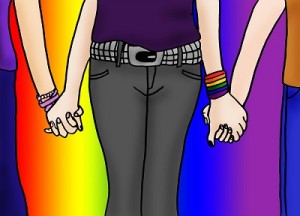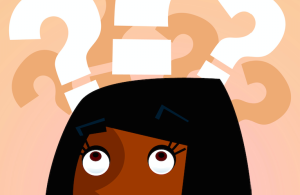
Two people hugging, happily. Source: LGBT Health Link
“…patients can be helped to live a ‘normal’ life only if their intersexuality is concealed.”
—American Academy of Pediatrics, 1996, via Intersex Society of North America
“For most of my life, I haven’t felt in control of my body. But what I can control is how people perceive this condition and my relationship with it. And I want to say that this is my body. And my story. Let me decide what’s to be done with it.”
—Inter/Act Youth, 17
Intersex conditions, or differences in sexual development (DSD), are typically non-life threatening, natural variations of internal and/or external sex anatomy among our bodies.
And they’re not uncommon. Intersex conditions are likely more common than cystic fibrosis –and possibly as common as green eyes.
So what’s the big deal?
The big deal is that as a society, we’re hooked on the idea of sex as a binary thing.
What’s the first thing said when a baby is born? “It’s a ______!” As if infants’ genital statuses are necessary information for us to continue cooing.
We’ve made some progress opening our minds: 50% of millenials believe gender falls on a spectrum.
But what if we acknowledged that bodies do, too?
Turns out there’s a rad group of youth doing just that.
Inter/Act is a youth-led advocacy group for young people with intersex conditions or DSD. And they’re spearheading a change in the way youth relate to and take ownership of their bodies.
Working alongside them is a community of deeply insightful parents and adult allies, many involved with the AIS/DSD Support Group and/or Advocates for Informed Choice (AIC).
When asked “What is your dream, and how do we get there,” visions abound of a world where intersex youth are free to determine the meaning of their bodies unbound by stereotypes, coercion, or cruelty.
The overarching theme of Inter/Act is one of profound possibility.
The nine points that follow are their insights on how we can get there.
1. Reconsider the Birds and the Bees Language
One of the most liberating moments in my assigned female body was in a Gender Studies class (duh). During one very powerful hour, over 200 of us sat in awe as we watched a slideshow of hundreds of vulvas.
The beautiful anatomical diversity washed me in a new self-love. Who knew? Middle school health class definitely didn’t cover natural variation in labia. Either you looked like the 2-D diagram or something was wrong with you.
Now imagine middle school health class, except you’re a boy with ovaries or a girl with XY chromosomes.
Teaching the spectrum of sexual and reproductive development is key to generating awareness of and support for intersex youth.
Before we drill them with stereotypes, youth are remarkably receptive to difference. Shown the true diversity of our bodies in early education, we probably wouldn’t bat an eye. Each of our noses is different, our hair’s sometimes many different colors, and our sex and reproductive organs are also unique! No biggie!
There’s a very toxic and hurtful misconception that an intersex condition is something to be “fixed.”
But nothing is broken by an intersex condition except for sex binary – which isn’t super reliable to begin with.
2. Don’t Hide Bodies from the Youth Who Live in Them
“There’s no such thing as an inappropriate question for a kid. Everything is appropriate. And if you don’t know the answer, you need to help them find someone who does.”
—Allison, 21, Inter/Act Youth
Almost every intersex youth you’ll speak to can recall a time when they knew information was being withheld from them. At home, at school, in the doctor’s office – because “you’re too young,” “it’ll scare you,” “it’s not appropriate.”
Denying intersex youth information is a form of communication itself. It says that information is dangerous and that your body is something to be ashamed of.
Historically, parents were told not to tell youth they were intersex because it’d cause depression, anxiety, and possibly suicide. Because of the concealment model of care, many folks don’t find out they’re intersex until adulthood when a secondary medical concern raises the need for testing.
Over the years, hundreds of intersex youth and adults have spoken out against secrecy, sharing the emotional and psychological devastation that results from having your body known to others but not to you.
Transparency with intersex youth doesn’t mean a 4-year-old needs to have a complex understanding of 5-alpha-reductase-deficiency.
For example: “Most girls have red juices, and most boys have blue juices, and you have extra blue juice” enables youth to know about their body’s relationship to hormones in an age-appropriate way.
“Parenthood isn’t like the yellow brick road: There are a lot of ways you can become a parent because people make families in all kinds of ways” lets youth know that they might not grow a baby in their tummy, but their possibilities are still endless.
And as youth grow, we can naturally adapt the words we use to become more sophisticated.
So while an intersex youth might not (yet) be a genetics professor, they live in their bodies.
And we should be talking to them – especially when it’s about parts of their bodies that society is going to send them inaccurate or negative messages about.
3. Advocate for the Rights of Intersex Youth in the Doctor’s Office
Prior to the mid-20th century, intersex conditions were largely free of medical intervention, mostly due to limited technologies.
But in 1965, psychologist John Money established the medical protocol of performing genital surgery on intersex infants and encouraged parents not to tell their children.
This protocol held strong for 40 years until the advocacy of folks who had been involuntarily operated upon, many under the stewardship of Intersex Society of North America founder Bo Laurent (also known as Cheryl Chase), gained enough traction to get doctors to admit that the protocol was made in error.
Unfortunately, Money’s impact remains, and many medical professionals still engage in misinformed and coercive care practices.
Most intersex youth and their families can recall multiple negative experiences with doctors. From unnecessary surgical procedures, to exploitative use of youths’ bodies for educational purposes, to information delivered in fear and negativity, to sexual abuse – the loss of control experienced by an intersex youth in a doctor’s office can be profound.
“I just had to cooperate and go along with everything the doctors said. Later, I realized everything they asked of me wasn’t okay, but I didn’t realize I could say no.”
—Inter/Act Youth, 16
Age plays a huge role here. Inter/Act’s publication, What We Wish Our Doctors Knew, features many tips that address the adultism of the medical profession: Be honest. Tell me the truth. Don’t lie to me.
In addition, the doctor’s office is a place where other identity-based barriers can arise in force – particularly when seeing a specialist.
Income, insurance, and documentation status can limit access to quality health care. If English isn’t spoken in the family, care can be compromised. Racism in health care continues to impact health outcomes among people of color.
Ultimately, there’s only one intersex condition (of 30) that can lead to a medical emergency. Instead, nonconsensual cosmetic surgery on functioning genitals (i.e.: clitoral reduction) is rooted in the medical assumption of heterosexual, vaginal sex combined with an incredibly narrow standard of beauty.
For this reason, most intersex advocacy groups vehemently oppose irreversible genital “normalizing” surgery at infancy.
And yet this surgery is estimated to occur on 4-5 babies each day.
The pressure to “fix” intersex bodies is almost always a result of society’s binary model of sex.
Dr. Arlene Baratz – advocate, parent of two intersex youth, and board member of AIC and AIS-DSD Support Group – states, “Every birthing room practitioner needs to know that the first thing you say to parents of an intersex child isn’t ‘We’ll fix this.’ It’s ‘You have a beautiful child who will be healthy and happy. We’ll give you resources and connect you with others.’”
For more information, check out AIC’s Know Your Rights handout for intersex youth and their families.
4. ‘It’s My Story’: Respect Confidentiality
Families must respect intersex youths’ decisions about when and if they’re comfortable disclosing.
Like LGBTQA+ youth, intersex youth navigate a delicate coming out process. As you probably remember, having any sort of difference during childhood or adolescence is pretty scary, meaning coming out is usually the result of a long and thoughtful process.
As a parent, adult ally, or friend, you might feel the to disclose about an intersex youth in order to build a support system for yourself. This isn’t a bad thing – caretakers need care-taking, too! But if you’re interested in reaching out to someone, include youth in the conversation – ask them if they are comfortable with that and honor their response.
Some youth have found power in the choice to be public about their intersex condition. Others are resolutely not out – sometimes because they’re just not compelled to, and sometimes out of fear of a negative response.
“Disclosing is completely up to me. Just because I’m born intersex doesn’t mean I have to. I should feel safe and comfortable doing that because I want to without being burdened by burning out by needing to educate people.”
—Inter/Act Youth, 23
5. Let Youth Tell You What Being Intersex Means to Them
Intersex is a physiological phenomenon – not a sexual or gender identity.
The “I” is often included in “LGBTQA+,” which can confuse us about whether or not intersex is an identity. The “I” is included because intersex folks often experience the same hetero- and cissexism faced by LGBTQA+ folks.
Some folks never come out as intersex because it doesn’t register as an identity: one intersex youth compared his condition to having allergies.
For others, claiming intersex as an identity grows over time – after attending conferences, connecting with other youth, and finding pride and community, it becomes part and parcel of who they are.
Ultimately, it’s the same as with any other piece of ourselves – we have the right to tell others what it means to us.
6. And What, If Anything, Being Intersex Has to Do with Gender
A lot of the hubbub around intersex conditions comes from the belief that genitals equal gender. And gender equals male or female. So when there’s some ambiguity there, what does it all mean?!
Fortunately, the increasing visibility of trans and gender non-conforming folks means we’re coming to understand that assigned sex doesn’t pre-determine gender.
That’s the beautiful thing about gender! It’s ours to determine. It’s fluid, and what it means to me may be worlds apart from what it means to you.
Intersex folks are no different in their relationship to gender.
The medical profession lags substantially in the conflation of sex and gender. As one doctor told a parent upon learning her child was intersex, “It’s too bad you named her XYZ. That’s a really feminine name, and we don’t yet know how she’s affected in the brain.”
Some advocates feel that intersex youth should be assigned a gender at birth, if for no other reason than social ease. However, it’s important for everyone to make space for youth to let us know when and if they feel differently than they were assigned.
No infant is born stating their gender. Anyone may grow to identify as a girl, as a boy, as genderqueer, as agender – and it’s up to their family and community to affirm them.
This doesn’t necessarily have to be a difficult conversation.
As one parent told her intersex child, “One of the things about your special body is the people who knew you first made their best guess about how you would feel. But you can feel differently, and that’s totally fine – we’ll always love you.”
Shortly after, that child shared that they did, in fact, get it wrong. “We thought he was a girl, and we had it wrong. And when he came to understand it, he told us differently. So we followed his lead.”
7. As a Parent or Adult Ally, It’s Okay to Feel Feelings
It’s natural to feel some feelings as a parent or adult ally of an intersex youth. Fear, discomfort, loss, shame, and guilt are part of the cycle of accepting things that turn out differently than we expected.
But amid the confusion, it’s the adult’s responsibility not to place those feelings on youth.
Some may become angry with their child while trying to locate blame for their difference. Others live in fear. Others choose to turn off the discomfort and pretend it’s not there.
Intersex youth often become parentified, helping adults to cope, assuaging their fears, locating accurate information, and identifying support networks.
This has consequences on a youth’s ability to tend to their own needs: “I feel for my mother, but sometimes I have to feel for myself more.”
Many resources are available for parents to find support that doesn’t place the burden on their children. For more information, check out Inter/Act’s super helpful guide What We Wish Our Parents Knew.
8. Find and Facilitate Community
On one hand, intersex youth deserve transparency. And on the other, safety. So what does that add up to? Community!
Community can mean everything. At minimum, community means finding and celebrating reflections of ourselves that aren’t centralized in everyday life.
What makes community both vital and challenging for intersex youth is that an intersex condition isn’t physically apparent.
Instead, the first point of community is usually online. From there, community blossoms. According to one community member, the intersex community is “still small enough that if someone reaches out, we personally reach back.”
This is powerful. Often meeting another intersex youth is “the game changer.”
“The first time I never felt shame was when I went to a convention and met 100 other intersex kids. Before that, I logically knew there had to be others, but I never felt more alone.”
Which takes us to the final point:
9. Educate Yourself, Educate Others, and Work to Increase Visibility
In the last 20 years, adults began to share their experiences of trauma and medical coercion during years of silence as youth.
Then, in the last 15 years, parents of intersex youth began to crop up seeking support.
Today, intersex youth themselves are for the first time steering the conversation.
Many people will never hear of intersex conditions or DSD until they personally know and love an intersex person. Many others never will hear of it at all. Most of us will live in communities where the sex and gender binaries are alive and kicking.
In following the leads of powerful intersex advocates, we can begin to unravel those confines and make space not only for intersex youth, but for all our natural differences.
First and foremost, begin by noticing and neutralizing your everyday language.
Meeting a new baby? Rather than asking the sex, ask the name and how the older sibling is getting along.
Discussing genetics? Refrain from linking XX with “woman” and XY with “man.” Instead, depict DNA as a map with many paths.
Asking for a tampon in a women’s restroom may seem harmless, but can cause unnecessary pain for a woman without typical reproductive anatomy.
Accept that you can’t and shouldn’t assume others’ bodies look any more like that health class diagram than your own.
As always, when you hear someone using hurtful language, step in and let them know it’s not appropriate.
When someone discloses an intersex condition to you, be supportive and teachable.
Celebrate Intersex Awareness Day on October 26th. Host a viewing session of The Interface Project in your community. View The 5 Best Things About Having AIS and MTV’s Faking It series (informed by Inter/Act!) with your friends. Share articles (like this one!) on social media and with your colleagues and contacts.
These tweaks are simple, but significant gestures that create space for intersex folks to feel safe and valued.
Ultimately, this is a conversation about widening our language and minds to embrace natural bodily variation, eliminating shame and stigma, and moving us toward genuinely celebrating our differences.
And as always, remember the power of the insights of youth. Don’t just pay attention to them – respect them and believe them. Step back and support them in being at the helm of their bodies and their lives.
For broader advocacy efforts, join, follow, or donate to these incredible organizations:
- Inter/Act
- Advocates for Informed Choice
- AIS-DSD Support Group
- Intersex Society of North America
- Accord Alliance
[do_widget id=”text-101″]
Kel Kray is a Contributing Writer for Everyday Feminism. Kel is a fiercely friendly social justice warrior who spends their days advocating with and on behalf of queer youth at an LGBTQIA+ youth center in Philly. A firm believer in the transformative power of dialogue, Kel coordinates a youth-driven education and training program that facilitates community workshops on gender and sexuality with an intersectional lens. Read Kel’s articles here.
Search our 3000+ articles!
Read our articles about:
Our online racial justice training
Used by hundreds of universities, non-profits, and businesses.
Click to learn more




















